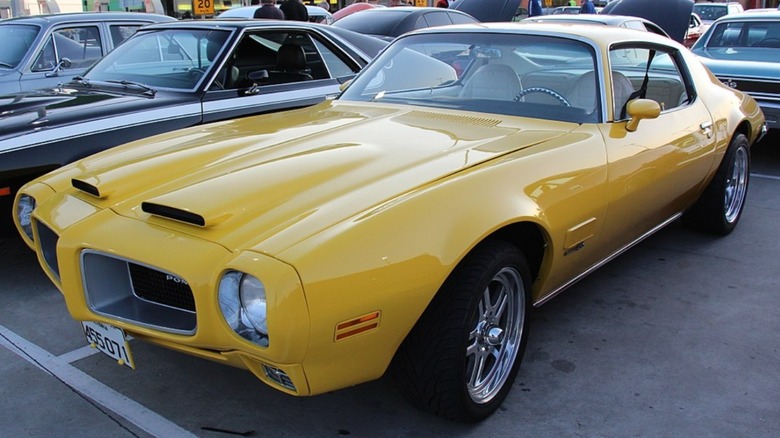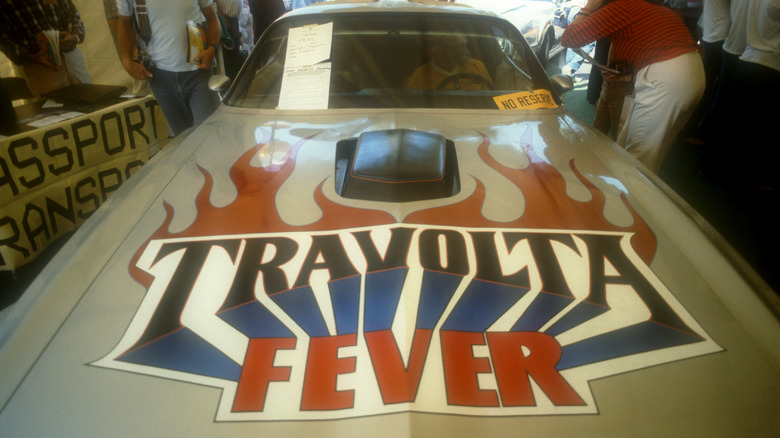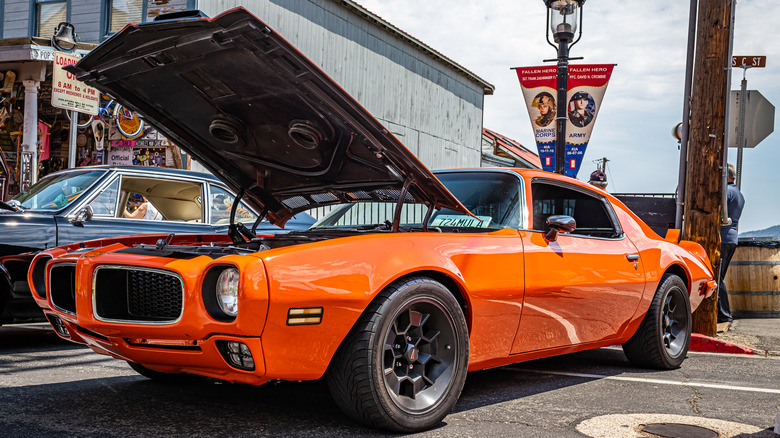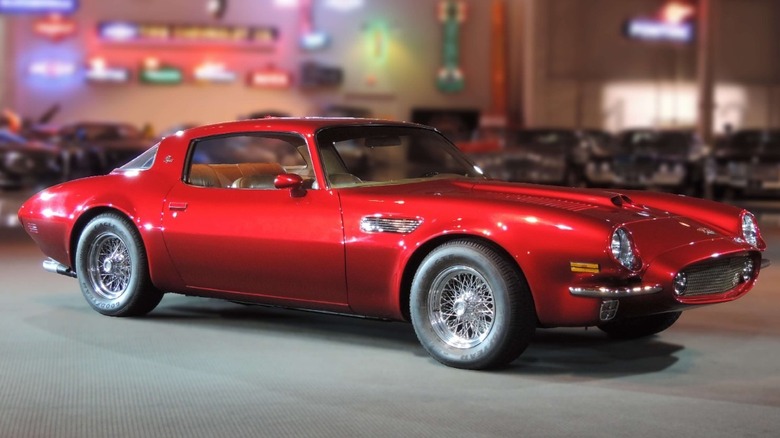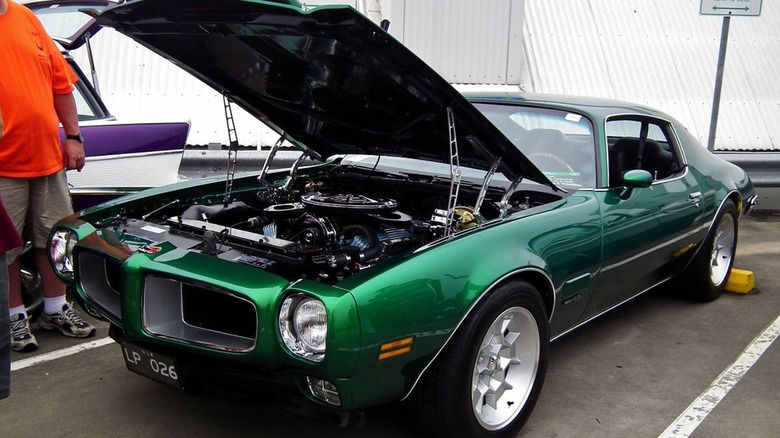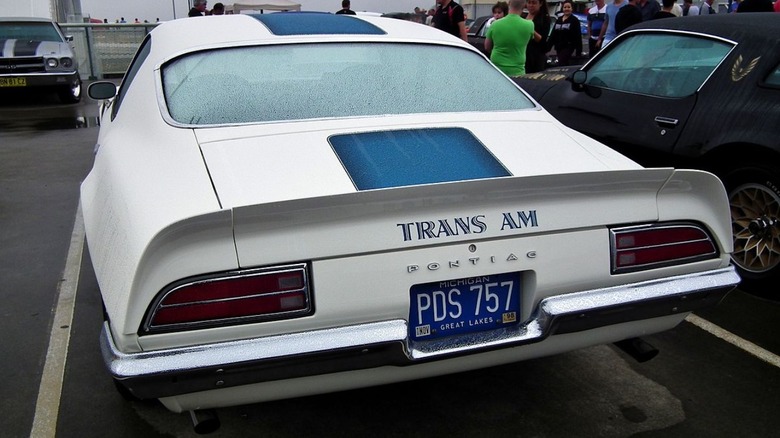5 Facts About The 1971 Pontiac Firebird Probably Only Hardcore Car Fans Know
Fans of classic vintage cars often come in two categories: Those who owned a model when it was new and had the pleasure of seeing it grow into an icon, and those younger drivers who grew into petrolheads and developed a taste for the wide and ever-popular world of vintage vehicles. Whether you first owned a '71 model in 1971 or in the 2020s, though, ultimately doesn't matter. A classic is a classic, and 1971's Pontiac Firebird certainly qualifies.
The Pontiac Firebird first arrived on the scene in 1967, as fans of "Fast N' Loud" will surely know: the show's Richard Rawlings owned the coveted 001 model, dating back to that year. The popular pony didn't hit its true potential right out the gate, with the Trans Am's launch two years later (for purchase that is), but a new generation of remarkable Firebirds wasn't far behind.
The 1971 Firebird was a second-generation model, arriving at a crucial time for the pony car. The mighty Ford Mustang was on the rise, "Smokey and the Bandit" was still a few years away, and the Firebird had to demonstrate that it could continue the momentum that the first generation had built. Along the way, The 1971 model would differentiate itself in some intriguing ways. John Travolta would become inextricably linked with the car, if you can believe it. Here are some interesting facts about this particular model year of Firebird.
[Image by Sicnag via Wikimedia Commons | Cropped and scaled | CC BY 2.0]
The one-of-a-kind Travolta Fever Firebird seems to have been a 1971 model
When it comes to fevers, the one most would associate with John Travolta would of course be "Saturday Night Fever" — symptoms presumably including chills that multiply and losin' control. However, for true connoisseurs of classic Firebirds, the 1971 "Travolta Fever" is even more notable.
George Barris' customized Firebird, according to Old Cars magazine in 2007 (via Trucks & Auto Auctions), was a 1971 model that featured a unique aesthetic indeed, after a brush with Barris' artistic temperament eight years later. Its exterior color scheme, on the whole, is light and rather muted gray, with red and blue stripes along the sides. It boasts a centerpiece that dials it up to delightfully garish levels: The words "Travolta Fever" emblazoned across the hood. Needless to say, some exaggerated and elongated lettering is utilized, along with stylized flames.
Do these flames represent the vehicle's name, Firebird? Or perhaps the flammability of Travolta's own scalp after all that hairspray he had applied for his star turn in "Grease?" That remains unclear. What is known is that the custom model was first created as a 1979 Revell model car, Though Barris pulled out all the stops for the interior of the full-size model. This Firebird featured a saddle and seats festooned in cowhide, seemingly in reference to "Urban Cowboy." Whether the real-size model was a '71 or a later Firebird, that model year has become inextricably connected with ... this design.
It could have been one of the very last Firebird model years
Admiring the wide range of classic vehicles at any vintage show is a joy, but there's something important that the sight of such cars alone won't give you: Context. If you owned a Firebird in the early 1970s, or if you've since caught up on the history of these majestic machines, you'll know that the Firebird's fate could have been sealed forever around this time.
For one glorious, excessive period around the late 1960s, what drivers seemed to want from manufacturers was the mighty pony car: The powerhouse Mustang, the AMC Javelin, and Mercury's Cougar are just some iconic examples. It's vital for manufacturers never to rest on their laurels, though, because wider driver tastes can be extremely fickle. The Firebird had a triumphant debut in 1967, with over 82,500 opting to saddle up on the new pony. Unfortunately for Pontiac, the model's level of success wouldn't prove to be consistent. In 1972 (the model year of the Firebird Formula pictured here), Curbside Classic reports that sales had fallen by more than half at 30,000.
At the time, the powerful pony cars were in some trouble. As Popular Mechanics reported in December 1972, a "rise in imported small sportsters" had caused sales of the mightiest ponies to fall, noting "this market is so ill that many observers believed GM would discontinue the Camaro and Firebird after 1972." 1979's sales figures of 212,000 Firebirds, however, prove that the vehicle recovered.
It was the basis of the incredible Pontiac Firebird Pegasus concept car
With the Firebird becoming the icon it is, it's perfectly understandable that its formidable body was used as the basis of several concept vehicles. In fact, it began its life as a concept vehicle, in the shape of the Firebird program (which brought the world the likes of the proudly finned and futuristically-domed Firebird III concept in 1958). The later Pegasus, however, was something distinctly different.
The model was, technically speaking, a 1971 Firebird, as it was created that year. However, the basis for it was actually a '70 model year Firebird. The experimental vehicle was then equipped with a Ferrari transmission and V12 365 GTB engine. Of the machine, Motor Trend quotes designer Jerry Palmer of Chevrolet as remembering, "I did a four-by-two-foot sketch early on with a [1958 Ferrari 250] Testa Rossa front end on it. Then Bill Mitchell broke my heart and took it down to Pontiac."
The result had considerable power in its 352-horsepower engine — fitted by adjusting the engine bay so that interior room wasn't compromised. Along with it came lashings of sleek style, courtesy of the bright red paint job augmented by the pinstripe pattern along the top of the body. Not to mention those Borrani wheels and the plush leather interior. Mitchell was so fond of the Pegasus that it was the only model he took with him upon retiring, returning it to the company in his will.
One of the biggest changes made for the 1971 Trans Am is hidden under the hood
Any Firebird enthusiast will tell you that the leap from the '70 to the '71 wasn't exactly revolutionary. There was little change between the models, especially from the outside. However, looking a little deeper reveals that some considerable change has actually taken place. Firm bucket seats were implemented for the powerful Trans Am this model year, and the all-important engine went through something of a major upgrade for this iteration of the car.
This was the year the 455 HO was introduced, and the difference it made was immediately apparent. With power being paramount for the pony car, a drop in horsepower between model years is naturally going to be rather less than ideal, but it was unavoidable with new oil crisis legislation that now controlled the vehicles of the United States. The Clean Air Act became law on the very last day of 1970, and so the '71 was the first new model year of the Firebird family to arrive in its wake. The 455 V8 HO engine of the Trans Am took a hit in raw numbers compared to its '70 counterpart, boasting 35 horsepower less at 335 horsepower.
It wasn't until 1973 that the 455 Super Duty was first introduced, but this original V8 proved remarkably resilient in the face of a market that was then rather hostile to powerful pony cars.
[Image by sv1ambo via Wikimedia Commons | Cropped and scaled | CC BY 2.0]
1971 Trans Am automatics were a real rarity
Pony cars of the late 1960s and early 1970s can be particularly hot collector's items. For any collector, of course, there's one truth: the rarer, the more appealing. With the 1971 Firebird, this meant seeking out the rarer Trans Am edition, and in an even more uncommon configuration beyond that.
The second generation of the Firebird began in 1970, and the Trans Am, an upgraded take on the base model, had arrived the year before. For 1971, it could boast an OHV V8 engine with an output of 335 horsepower and 480 pound-feet of torque — quite formidable at a time when on-paper vehicle power was on a downturn with harsher regulations. These factors made it expensive for many at the time, though: that original $4,595 price point, over 50 years later, translates to about $34,577 as of 2023.
This being a premium model, then, it was not available in the same quantities as its standard counterpart: there were 2,116 Trans Am sales that year. This would make them a prized commodity in the vintage Trans Am community, but there was another factor in some cases, as 1,231 of those vehicles were built with an automatic transmission. Motor 1 reports that manuals had only a 1% U.S. penetration early in 2023, indicating that such transmissions have long occupied an interesting position in the nation's driving history.
[Image by sv1ambo via Wikimedia Commons | Cropped and scaled | CC BY 2.0]
